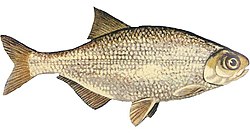| Featherbacks Temporal range: Late Cretaceous to present | |
|---|---|
 | |
| Chitala ornata | |
| Scientific classification | |
| Domain: | Eukaryota |
| Kingdom: | Animalia |
| Phylum: | Chordata |
| Class: | Actinopterygii |
| Order: | Osteoglossiformes |
| Family: | Notopteridae Bleeker, 1859 |
| Genera | |
See text | |
The family Notopteridae contains 11 species of osteoglossiform (bony-tongued) fishes, commonly known as featherbacks and knifefishes. These fishes live in freshwater or brackish environments in Africa and West, South, East and Southeast Asia.
Contents
With the denotation of "knifefish", the notopterids should not be confused with Gymnotiformes, the electric knifefishes from South and Central America. Although their manner of swimming is similar and they are superficially similar in appearance, the two groups are not closely related.
A few of the larger species, especially Chitala ornata, are food fish and occasionally aquarium pets. The name is from Greek noton meaning "back" and pteron meaning "fin".


